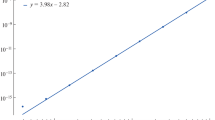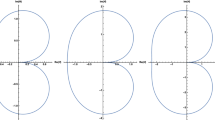Abstract
For the purpose of overcoming the difficulty of the so-called “intermediate expression swell” in applying computer algebra, a semi-inverse algorithm is proposed. The order of seeking solutions for various problems is partly inverted, i. e., the intermediate expressions appearing in computation are “frozen” in the symbolic form at first, and “unfrozen” till the formal expressionsof final solutions are found out. In this way, the overflow due to the shortage of saving space is avoided. The applications of the algorithm in the problems on nonlinear oscillation, dynamical optimization and interfacial solitary waves are described, which show the effectiveness of the semiinverse algorithm.
Similar content being viewed by others
References
J. Calmet and J. A. Van Hulzen. Computer algebra application, inComputer Algebra Symbolic and Algebraic Computation, Ed. by B. Buchberger et al., 2nd Ed., World Pub. Co, Beijing (1988), 245–258.
A. I. Beltzer, Engineering analysis via symbolic computation—A break through,Appl. Mech. Rev.,43 (1990), 119–127.
M. Van Dyke, Computer-extended series,Ann. Rev. Fluid Mech.,16 (1984), 287–309.
H. R. Rand and D. Armbruster,Perturbation Methods, Bifurcation Theory and Computer Algebra, Springer-Verlag, New York (1987).
Zang Hongming, Investigation of several problems in mechanics via perturbations and computer algebra, MS Thesis, Shanghai University of Technology (1993). (in Chinese)
Zhang Hongming, Application of symbolic computation in perturbation techniques,J. Shanghai Univ. Technol.,12 (1991), 283–288 (in Chinese)
Zang Hongming and Dai Shiqiang, Computer algebra solution for a nonlinear oscillation equation,J. Shanghai Univ. Technol.,14 (1993), 189–197. (in Chinese)
Dai Shiqiang, PLK Method, inSingular Peturbation Theory and Its Applications in Mechanics, Ed. by Chien Weizang, Science Press, Beijing (1981), 33–86. (in Chinese)
Zang Hongming and Dai Shiqiang, Higher-order solutions for interfacial solitary waves in a two-fluid system,Proc. Inter. Conf. on Hydrodyn., China Ocean Press, Beijing (1994), 691–695.
Dai Shiqiang, Solitary waves at the interface of a two-layer fluid,Applied Mathematics and Mechanics (English Ed.),3, 6 (1982), 777–788.
Wang Mingqi and Dai Shiqiang, Computer algebra-perturbation solution to a nonlinear wave equation,Applied Mathematics and Mechanics (English Ed.),16, 5 (1995), 421–428.
Author information
Authors and Affiliations
Additional information
Project supported by the National Natural Science Foundation of China and Shanghai Municipal Natural Science Foundation
Rights and permissions
About this article
Cite this article
Shiqiang, D., Hongming, Z. A semi-inverse algorithm in application of computer algebra. Appl Math Mech 18, 113–119 (1997). https://doi.org/10.1007/BF02458010
Received:
Issue Date:
DOI: https://doi.org/10.1007/BF02458010




